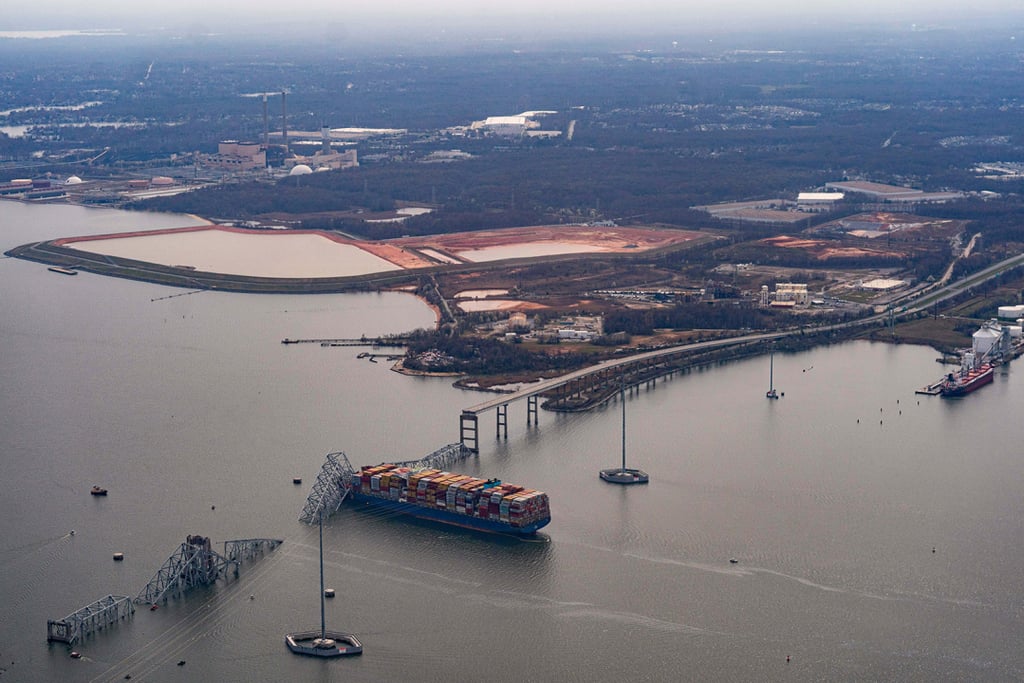Baltimore bridge collapse: a structural risk engineering perspective.
RISK MANAGEMENTSTRUCTURAL RISKCOLLAPSE
3/29/20244 min read


Perhaps calling it a ‘collapse’ is unfair for the bridge and its original designers. The 366m main span of the Francis Scott Key Bridge has successfully withstood its daily demands for almost 50 years since the bridge’s opening and has managed to connect two main roads at its ends while allowing enough clearance for the endless parade of maritime vessels docking at the Port of Baltimore. The bridge has complied with its original design objectives.
Professor Colin Caprani perhaps found the best way to describe the incident by simply summarising it as a 20th-century bridge meeting a 21st-century ship. When a modern +100,000-ton ship impacts one of the main supports of a 1970s bridge, the consequences become grossly obvious for modern engineers, but may not have been so for the original designers, who rightly designed protection systems (e.g., dolphins and fenders) that would seem absurd in today’s context of commercial sailing. This led to the failure of a bridge that did not have the strength or redundancy to cope with the modern demands, resulting in the loss of multiple lives (with the exact figure not yet confirmed), enormous disruption to both the roads and the waterway, and will likely become, as McGill and Partners suggest, the largest example of port blockage seen in recent years.
Putting the cart before the horse.
Larger planes force airports to build longer runways. The Panamá Canal itself was expanded to accommodate larger ships in higher numbers. Yet, somehow, the vulnerable Francis Scott Key Bridge, exposed to the hazard of ever-growing ships, was overlooked and consequently not dealt with. The hazard gradually increased without addressing the vulnerability issues first.
In our field, we often consider that little-to-nothing can be done to attenuate the hazard component of risk. Earthquakes cannot be avoided. Tornadoes cannot be dissipated (although climate change has a role, that is a different story). Volcanoes cannot be turned off. Yet, there is a whole set of hazards that can be significantly reduced by taking engineering measures. For example, the risk of a key column in a skyscraper being impacted by a heavy vehicle can be reduced by simply incorporating barriers in the building’s architecture, such as bollards. The US Embassy in London protects its building from vehicle impacts and deliberate explosions by employing discreet trenches hidden by the plants, benches, and ponds surrounding the 12-story building. Perhaps we cannot realistically reduce the size of the ships (that ship has sailed with globalisation). Yet, in tight ports, container ships such as the MV Dali are escorted by low-speed tugs that restrict the free roaming of the ship. Despite not being a narrow passage, the vulnerability of the surrounding infrastructure should equally trigger a requirement to address other components of risk (i.e., hazard) before the disaster strikes.
Closing the barn door after the horse has bolted.
Using tugs to accompany every boat could reduce the efficiency of the port. Restricting the size of the ships could certainly have an unbearable economic impact on the city’s (and region’s) economy. Perhaps it is not feasible to reduce the hazard; thus, the vulnerability and exposure issues should be addressed as a priority. Modernising the protection measures of the bridge could be a path forward, yet how do you protect a structure from such a colossal mass impacting it? How do you increase the redundancy of an existing truss bridge with four slender supports at the ends of a 366m span? Perhaps intermediate islands or rock walls to support new sturdier piers. Perhaps a combination of these with larger and more modern dolphins and fenders.
Although it would be impossible to propose the ideal solution without knowing in depth the local conditions and constructional constraints, the solution may resemble those taken in modern passageways around the world. A sturdier bridge with better defenses, a tunnel structure that removes the exposure to ships, or a bridge-and-tunnel configuration taking advantage of the existing artificial islands and peninsulas in the bay could be the way forward. Evidently, any of these solutions come with a significant price tag that should not be compared to its benefits by considering only the millions of dollars put into the cost of the project, but also the associated losses that could be avoided due to the interruption of trade in the port, which, in this specific incident, may be counted in the billions.
The elephant in the room.
Although a ship impacting a bridge is an extremely rare event, the economic losses associated with these events should not only be limited to the cost of repairing, retrofitting, strengthening, or replacing the civil structure, but also to the indirect losses that could arise from an operational paralysis of the port, city, and region. It is not enough to monitor the structural health of our existing infrastructure. It is necessary to reevaluate periodically the potential impact that modern and future hazards could have on them and on the economic and societal systems that rely on their correct operation within a risk-based scenario.
It is important to raise some questions for the future: How many Francis Scott Key Bridge situations do we have in key infrastructure around the world? How much can this case be extrapolated to other key sectors such as nuclear, energy, health, transportation, and defense? How vulnerable is our infrastructure if the hazard is no longer accidental, but a result of hostile country aggression or terrorism? Relying only on the unlikeliness of the hazard to occur is betting on the (overly) optimistic hope that these events can only result from accidents.

